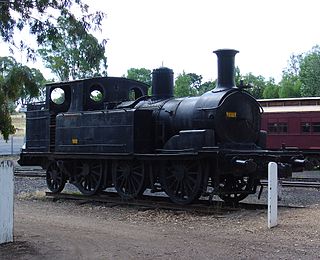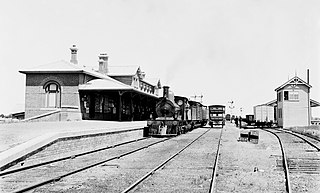Related Research Articles

The Victorian Railways J class was a branch line steam locomotive operated by the Victorian Railways (VR) between 1954 and 1972. A development of the successful Victorian Railways K class 2-8-0, it was the last new class of steam locomotive introduced on the VR. Introduced almost concurrently with the diesel-electric locomotives that ultimately superseded them, the locomotives were only in service for a relatively short time.
The DD class (later reclassified into D1, D2 and D3 subclasses) was a passenger and mixed traffic steam locomotive that ran on Victorian Railways from 1902 to 1974. Originally introduced on mainline express passenger services, they were quickly superseded by the much larger A2 class and were relegated to secondary and branch line passenger and goods service, where they gave excellent service for the next fifty years. The DD design was adapted into a 4-6-2T tank locomotive for suburban passenger use, the DDE (later D4) class. They were the most numerous locomotive class on the VR, with a total of 261 DD and 58 locomotives built.

The AA class was an express passenger locomotive that ran on the Victorian Railways between 1900 and 1932. The largest, heaviest and most powerful 4-4-0 steam locomotive to run in Australia, it was the final development of this locomotive type in Australia.

The mainline passenger locomotives, later classified as B class, ran on the Victorian Railways (VR) between 1862 and 1917. They used a 2-4-0 wheel arrangement, which provided greater traction on the new, more heavily graded Geelong–Ballarat railway and the Melbourne-Bendigo-Echuca railway, as opposed to the 2-2-2 arrangement previously selected for the relatively level Geelong line. The B class locomotives are regarded as the first mainline VR motive power, and were highly successful in passenger operations.

The Victorian Railways M class were 4-4-0T (tank) steam locomotives for suburban passenger service in Melbourne, a pattern engine being supplied in 1879 by Beyer, Peacock & Co. Twenty-one further locomotives of this model were built by the Phoenix Foundry of Ballarat, in three batches, from 1884 to 1886. They were numbered 40, 210-240, and 312-320, and were classed M in 1886.
The Victorian Railways V class of 1857 was a class of 0-6-0 goods locomotives operated by the Victorian Railways between 1858 and 1904, built by George England and Co., Newcastle upon Tyne, England.

The Victorian Railways Z class were three locomotives built in 1893 in Victoria, Australia

The E class was a class of suburban tank steam locomotive that ran on Australia's Victorian Railways (VR).

The Victorian Railways F class was originally a class of 2-4-0 light line passenger locomotives operated by the Victorian Railways between 1874 and 1929.
The Victorian Railways X class was a class of 0-6-0 mainline goods locomotives operated by the Victorian Railways between 1886 and 1920.
The Victorian Railways G class was a class of 4-4-0 light line passenger locomotives operated by the Victorian Railways between 1877 and 1904.
The Victorian Railways H class was a class of 4-4-0 light line passenger locomotives operated by the Victorian Railways between 1877 and 1916.

The D class of 1887 were Phoenix-built locomotives to be used on Victorian Railways.
The D class of 1876 was the first example of American-built locomotives to be used on Victorian Railways, and among the first such engines to operate in Australia.
Victorian Railways No.1 was the first government passenger steam locomotive on Victorian Railways (VR). It was a 2-2-2 tender locomotive built in 1857 by George England & Co. with their builders number 146. It arrived at Port Phillip in September 1858 along with 4 goods locomotives of 0-6-0 tender configuration.
The Victorian Railways J class of 1859 was a class of 2-2-2 main line passenger locomotives operated by the Victorian Railways between 1860 and 1912, built by Beyer, Peacock & Company, Manchester, England.
The Victorian Railways P class was a class of 0-6-0 goods locomotives operated by the Victorian Railways between 1860 and 1921, built by Beyer, Peacock & Company, Manchester, England.
The Geelong & Melbourne Railway Company operated a total of 1 locomotive that fell under the Whyte notation of 0-4-0T, with a Vertical boiler, between 1855 and 1860. Later it was operated by the Victorian Railways between 1860 and 1893. This was the second locomotive manufactured in Australia.
The Geelong and Melbourne Railway Company operated a total of four 2-2-2WT locomotives between 1856 and 1860. They were later operated by the Victorian Railways between 1860 and 1889.
References
- Dee; et al. (1981). Power Parade. Melbourne: VicRail Public Relations Division. p. 3. ISBN 0-7241-3323-2.
- Cave, Norman; Buckland, John; Beardsell, David (2002). "Chapter 4". Steam Locomotives of the Victorian Railways. Vol. 1: The First Fifty Years. Melbourne, Vic: ARHS Victoria Division. pp. 33–36. ISBN 1876677384.
